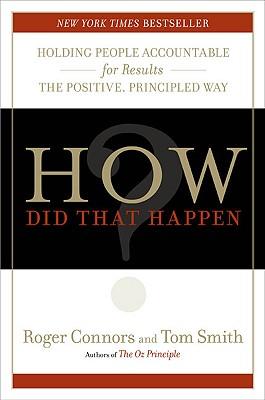How Did That Happen? Summary
4 min read ⌚
 Holding People Accountable for Results the Positive, Principled Way
Holding People Accountable for Results the Positive, Principled Way
Blaming other people won’t get you far; holding them accountable might. Especially if you use the positive, principled way.
“How Did That Happen?” by Roger Connors and Tom Smith is here to teach you. And we to summarize it!
About Roger Connors and Tom Smith
 Roger Connors is one of America’s most famous management consultants and the CEO of Partners in Leadership. Together with Tom Smith, he has authored few books which have set down the foundations of the business science of accountability. Such as: “The Oz Principle” and “Change the Culture, Change the Game.”
Roger Connors is one of America’s most famous management consultants and the CEO of Partners in Leadership. Together with Tom Smith, he has authored few books which have set down the foundations of the business science of accountability. Such as: “The Oz Principle” and “Change the Culture, Change the Game.”
 Tom Smith is Roger Connors’ long-time business collaborator and the Co-President of Partners in Leadership.
Tom Smith is Roger Connors’ long-time business collaborator and the Co-President of Partners in Leadership.
“How Did That Happen? Summary”
Every now and then, something happens, and nobody understands how it had got to there. It can be a minor thing or a financial collapse of the economy; but, nevertheless, the question remains the same: “How did that happen?”
Nobody wants to points the finger back at them, so everyone finds someone to blame. Sometimes, even randomly. Don’t blame yourself – hey, this time you really can! – it seems to be a normal human reflex! We can talk about types of biases working in the background of it, but let’s just put it in layman’s terms so you can understand it right away:
Mistakes were made – but not by me.
OK, then – but by whom?
Well, Roger Connors and Tom Smith claim that it’s the wrong question to ask. The right one is really hard to deduce from their really contrived neologism-plagued writing. But, that may be the point, after all! Because it’s not about simple who’s-to-blame Q&As.
It’s about holding people accountable – and doing it in a positive way. You know, so they themselves are unaware that they’ve made a mistake.
In order to do this, you need to apply the “Accountability Sequence Model.” It’s a two-part model, based on three axioms.
The first axiom is the “Accountability Assumption.” It says that most people, once they know what’s expected of them, enjoy meeting and surpassing them.
The second axiom, the “Accountability Fallacy,” concerns the rest of the people, the flawed people, those who fail to deliver. But, that’s a wholly different problem which will never be solved by finger pointing.
Finally, the third axiom, the “Accountability Truth,” claims that leaders should always first see themselves as part of the problem. Because, if they’re dealing with one of the people covered in the first axiom, the unmet expectations are, really, wrongly related expectations.
Now, the two parts of the “Accountability Sequence Model” are the “Outer” and the “Inner Ring.” “The Outer Ring” coaches leaders how to appropriately establish expectations. The “Inner Ring” – how to help the people who don’t meet these expectations.
Of course, in a positive, principled manner.
The mechanisms of the Outer and the Inner Rings are the most important thing to take away from this summary. So, we’ll describe them briefly in our “Key Lessons” section.
Key Lessons from “How Did That Happen?”
1. The Three Axioms of the “Accountability Sequence Model”
2. The Four Steps of the Outer Ring of Accountability
3. The Four Steps of the Inner Ring of Accountability
The Three Axioms of the “Accountability Sequence Model”
Let’s repeat them. Because it’s very important for you to learн that you shouldn’t blame anyone; you should just hold your employees accountable. And your relationship is based on three principles.
First of all, the “Accountability Assumption”: most people want to meet expectations. Secondly, the “Accountability Fallacy”: very few people don’t want to; but, that’s an altogether different problem. Finally, the “Accountability Truth”: you, as a leader, should always see yourself as a part of the problem.
Because, if you take into consideration the first two axioms, most probably, you are.
The Four Steps of the “Outer Ring of Accountability”
Usually, employees fail to meet leaders’ expectations because they haven’t been related properly to them. This is what the “Outer Ring of Accountability” strives to take care of. In four steps.
First, you need to properly FORM expectations. Yes, FORM is an acronym! Meaning: the expectations should be frameable, obtainable, repeatable, and measurable. Just like those SMART goals of your company!
Then, you need to communicate these expectations with the self-explanatory why-what-when approach. Thirdly, you need to align the expectations. And, finally, you need to inspect them using the LOOK model: listen, observe, objectify, and know!
The Four Steps of the “Inner Ring of Accountability”
The “Inner Ring of Accountability” helps you find the real problem when expectations are unmet. It’s, once again a four-step process.
First of all, you need to examine the motivation; because it’s so important. And be sure to always set it right 0 by defining it, selling it, advocating it, and celebrating it!
Then, you need to evaluate the training. If everything’s right on your side, you will have to assess accountability in four steps: see it, own it, solve it, do it! Finally, consider the culture of your company. Maybe, that’s the part which needs to change!
Like this summary? We’d like to invite you to download our free 12 min app, for more amazing summaries and audiobooks.
“How Did That Happen?” Quotes
You cannot effectively hold someone accountable if you have not first formed clear expectations. Share on X All too often, people only become aware of boundaries after they cross them. Share on X In the strongest culture, everyone is accountable to everyone, regardless of position or the ability to influence others. Share on X Your particular style, which reflects your basic personality, greatly influences how you go about holding others accountable. Share on X True accountability is not about punishment. Share on X
Emir is the Head of Marketing at 12min. In his spare time, he loves to meditate and play soccer.


 Holding People Accountable for Results the Positive, Principled Way
Holding People Accountable for Results the Positive, Principled Way



